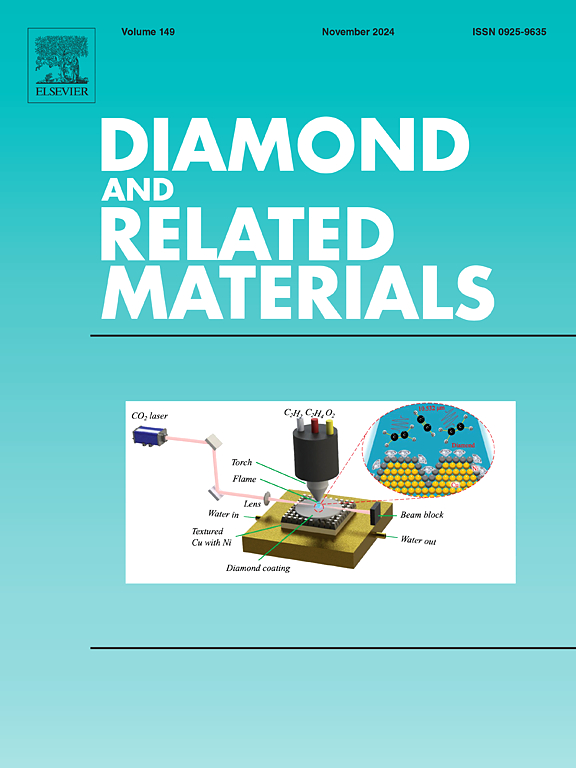用于场发射器件和温度/压力传感器的三维多孔激光诱导石墨烯涂层海绵
IF 4.3
3区 材料科学
Q2 MATERIALS SCIENCE, COATINGS & FILMS
引用次数: 0
摘要
最近对柔性传感器的兴趣,由于其可负担性,可穿戴性,轻量化设计和易于制造,推动了应用和基本理解的进步。在此,我们探索了三维(3D)石墨烯涂层海绵的合成路线,并研究了其机械和电子输运性质。拉伸和压缩测试表明,石墨烯涂层海绵的杨氏模量约为0.075 MPa。电学测量与欧姆接触显示直流电导率低至0.5 S/cm。浸水和超声搅拌下的粘接耐久性和润湿性测试证实了石墨烯涂层的强附着力和增强的疏水性,证明了其机械和化学稳健性。温度测量表明,随着温度的降低,海绵的电阻呈现出非单调的行为。当温度从295 K下降到200 K时,电阻在250 K左右出现一个明显的峰值,随后从200 K稳步上升到77 K。场发射测量表明,随着阳极与发射面间距的减小,电流稳定,导通电压降低,在阳极与阴极距离为300 nm时,导通电压约为13 V,场增强系数为286。利用Fowler-Nordheim模型对实验数据进行了分析,证明了在100-500 nm范围内,场增强因子与阴极-阳极分离距离呈非单调依赖关系。结果表明,这种柔性的三维石墨烯涂层海绵可以用作敏感热敏电阻、场发射体和压力传感器。本文章由计算机程序翻译,如有差异,请以英文原文为准。
3D porous laser-induced graphene coated sponges for field emission devices and temperature/pressure sensors
Recent interest in flexible sensors, fueled by their affordability, wearability, lightweight design, and ease of fabrication, has driven advancements in applications and fundamental understanding. Herein, we explore the synthesis route of the three-dimensional (3D) graphene-coated sponges and investigate their mechanical and electronic transport properties. Tensile and compression tests on the graphene coated sponges demonstrate Young's modulus of around 0.075 MPa. Electrical measurements with ohmic contacts show DC conductivity as low as 0.5 S/cm. Bonding durability and wettability tests under water immersion and ultrasonic agitation confirmed the strong adhesion and enhanced hydrophobicity of the graphene coating, demonstrating its mechanical and chemical robustness. Temperature measurements reveal a non-monotonic behavior in the sponge's resistance as the temperature decreases. The resistance exhibits a pronounced peak around 250 K as the temperature drops from 295 K to 200 K, followed by a steady increase from 200 K to 77 K. Field emission measurements show a stable current and a reduction in turn-on voltage as the spacing between the anode and the emitting surface decreases, revealing a low turn-on voltage of about 13 V and a field enhancement factor of 286 at an anode-cathode distance of 300 nm. Experimental data are analyzed using the Fowler-Nordheim model, evidencing a non-monotonic dependence of the field enhancement factor on the cathode-anode separation distance in the range of 100–500 nm. The results show that such a flexible 3D graphene coated sponge can be utilized as a sensitive thermistor, a field emitter, and a pressure sensor.
求助全文
通过发布文献求助,成功后即可免费获取论文全文。
去求助
来源期刊

Diamond and Related Materials
工程技术-材料科学:综合
CiteScore
6.00
自引率
14.60%
发文量
702
审稿时长
2.1 months
期刊介绍:
DRM is a leading international journal that publishes new fundamental and applied research on all forms of diamond, the integration of diamond with other advanced materials and development of technologies exploiting diamond. The synthesis, characterization and processing of single crystal diamond, polycrystalline films, nanodiamond powders and heterostructures with other advanced materials are encouraged topics for technical and review articles. In addition to diamond, the journal publishes manuscripts on the synthesis, characterization and application of other related materials including diamond-like carbons, carbon nanotubes, graphene, and boron and carbon nitrides. Articles are sought on the chemical functionalization of diamond and related materials as well as their use in electrochemistry, energy storage and conversion, chemical and biological sensing, imaging, thermal management, photonic and quantum applications, electron emission and electronic devices.
The International Conference on Diamond and Carbon Materials has evolved into the largest and most well attended forum in the field of diamond, providing a forum to showcase the latest results in the science and technology of diamond and other carbon materials such as carbon nanotubes, graphene, and diamond-like carbon. Run annually in association with Diamond and Related Materials the conference provides junior and established researchers the opportunity to exchange the latest results ranging from fundamental physical and chemical concepts to applied research focusing on the next generation carbon-based devices.
 求助内容:
求助内容: 应助结果提醒方式:
应助结果提醒方式:


